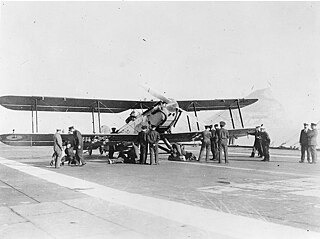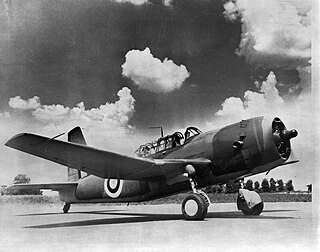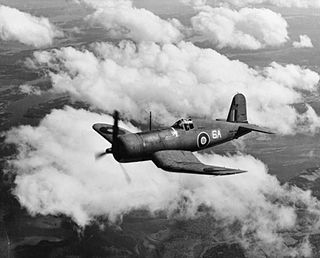
The 3rd Carrier Air Group was an aircraft carrier air group of the Royal Navy's Fleet Air Arm. It was formed in August 1945, based at HMS Nabbington, a Royal Navy, Mobile Naval Operating Air Base (MONAB), established at the Royal Australian Air Force (RAAF) base RAAF Nowra at Nowra, New South Wales, in Australia.
HMS Nabbington, was a Royal Navy (RN), Mobile Operational Naval Air Base (MONAB), that was established at the Royal Australian Air Force (RAAF) base RAAF Nowra at Nowra, New South Wales, in Australia during the final stages of the Second World War. HMS Nabbington was also known as MONAB I and Royal Naval Air Station Nowra.
HMS Nabberley was a Royal Navy (RN), Mobile Operational Naval Air Base (MONAB) at the Royal Australian Air Force (RAAF) base RAAF Bankstown in Sydney, Australia. HMS Nabberley was also known as MONAB II and Royal Naval Air Station Bankstown.
HMS Nabthorpe was a Royal Navy, (RN), Mobile Operational Naval Air Base (MONAB) situated at the Royal Australian Air Force (RAAF) base RAAF Station Schofields located at Schofields, New South Wales during the final year of the Second World War. HMS Nabthorpe was also known as MONAB III and Royal Naval Air Station Schofields.

718 Naval Air Squadron was a Fleet Air Arm (FAA) naval air squadron of the United Kingdom’s Royal Navy (RN) created on 15 July 1936 to serve as a Catapult Flight of the Fleet Air Arm. It was elevated to squadron status at the end of 1937, before being disbanded on 21 January 1940. It was re-formed on 5 June 1944 to operate as the Army Co-operation Naval Operational Training Unit before being disbanded again on 1 November 1945. On 23 August 1946 it was reformed for the third time to operate as a Seafire Conversion Squadron but was disbanded less than one year later, on 17 March 1947. On 25 April 1955, after almost a decade, the squadron was reformed once more to train RNVR on jet aircraft. Once this work was complete, it was disbanded for the final time on 31 December 1955.

719 Naval Air Squadron was a Fleet Air Arm (FAA) naval air squadron of the United Kingdom’s Royal Navy (RN). It initially formed in 1944 as a Fighter Air Firing Training Squadron, at HMS Vulture, RNAS St Merryn, within the School of Air Combat, but at the start of 1945 it disbanded into 794 Naval Air Squadron. The squadron reformed in 1946 at HMS Owl, RNAS Fearn, as a Strike Training Squadron, before moving to HMS Gannet, RNAS Eglinton, where it became an Anti-submarine Training Squadron, disbanding there in 1949. The squadron reformed the following year at HMS Gannet as the Naval Air Anti-submarine School and remained there becoming the Naval Anti-Submarine Operational Flying School, eventually disbanding in 1959. However, in 1960, the squadron reformed, again at HMS Gannet, as the Joint Anti-submarine School Flight, this time operating helicopters. 719 Naval Air Squadron was granted first line status on 5 October 1961 and renumbered to 819 Naval Air Squadron.

721 Naval Air Squadron was a Fleet Air Arm (FAA) naval air squadron of the United Kingdom’s Royal Navy (RN). 721 Naval Air Squadron formed at HMS Gadwall, RNAS Belfast, Northern Ireland, at the beginning of March 1945, as a Fleet Requirements Unit for the British Pacific Fleet. Initially equipped with Vultee Vengeance target tugs, it arrived at HMS Nabaron, RNAS Ponam, Admiralty Islands in May 1945, and commenced operations towing targets. The squadron moved to HMS Nabsford, RNAMY Archerfield, Brisbane, Australia, during October and then relocated to Hong Kong at the beginning of 1946, moving to HMS Nabcatcher, RNAS Kai Tak, where it eventually disbanded at the end of 1947.

732 Naval Air Squadron was a Fleet Air Arm (FAA) naval air squadron of the United Kingdom’s Royal Navy (RN). It was initially formed in 1943 from a requirement for an Operational Training Unit for United States trained FAA pilots flying Vought Corsair fighter-bomber aircraft, at RN Air Section Brunswick, USNAS Brunswick, Maine, United States, and disbanded during 1944. In 1945 it was reformed for a brief period, as a Night Fighter Training Squadron, operating out of HMS Nighhawk, RNAS Drem, East Lothian, Scotland. Notably equipped with six Avro Anson 'flying classrooms', amongst other aircraft.

757 Naval Air Squadron was a Fleet Air Arm (FAA) naval air squadron of the United Kingdom’s Royal Navy (RN). It was first formed as a Telegraphist Air Gunner Training Squadron in 1939, operating out of RNAS Worthy Down, but after three months it went into abeyance, only to reform again in the same role, at the same location, in 1941 and operating until 1942. It then reformed as a Fighter Pool Squadron & Operational Training Unit at RNAS Puttalam, in Sri Lanka, in 1943. After a brief spell at RNAMY Tambaram, in India, the squadron finally disbanded at RNAS Katukurunda, in Sri Lanka, at the beginning of 1946.

768 Naval Air Squadron was a Fleet Air Arm (FAA) naval air squadron of the United Kingdom’s Royal Navy (RN). It last disbanded at HMS Gannet, RNAS Eglinton, Northern Ireland, in March 1949, having been formed as a Deck Landing Control Officer Training Squadron, in December 1948, to ensure one American-style signal trained DLCO could be located at every FAA station. It first formed as part of the Deck Landing Training School at HMS Condor, RNAS Arbroath, in January 1941, as a Deck Landing Training Squadron. Advanced training was in HMS Argus, for which a detachment was maintained at HMS Landrail, RNAS Machrihanish, where it wholly moved to in March 1943. September saw a move to RAF Heathfield, Ayr, followed by a further move to HMS Sanderling, RNAS Abbotsinch in January 1944. Training used escort carriers on the Firth of Clyde and a detachment was maintained at (Heathfield)Ayr throughout this period, with the squadron returning there in July 1945, at this time HMS Wagtail, RNAS Ayr. In August the squadron moved to HMS Corncrake, RNAS Ballyhalbert in Northern Ireland but then in October it joined up with the Deck Landing School at HMS Peewit, RNAS East Haven, Scotland, where it disbanded in April 1946.

794 Naval Air Squadron was a Fleet Air Arm (FAA) naval air squadron of the United Kingdom’s Royal Navy (RN) which disbanded in March 1947. The squadron formed as an Air Target Towing Squadron, at HMS Heron, RNAS Yeovilton, during August 1940, although operated target tug aircraft out of the satellite, RNAS Haldon. In April 1943 it provided a detachment at RAF Warmwell as an air firing unit and three months later the squadron relocated to RNAS Angle and became the Naval Air Firing Unit. Further moves followed in quick succession, to HMS Goldcrest, RNAS Dale, in September, HMS Dipper, RNAS Henstridge, in November and HMS Heron II, RNAS Charlton Horethorne in December and by which time the squadron was designated No. 1 Naval Air Firing Unit, but disbanded in June 1944. The squadron reformed at HMS Vulture, RNAS St Merryn, in January 1945, as the School of Air Firing and later in the year was tasked to support the newly formed Ground Attack School. It moved to HMS Gannet, RNAS Eglinton, during August, and at this point had three flights providing courses for aerial warfare, airstrike and aerial reconnaissance.

1850 Naval Air Squadron was a Fleet Air Arm (FAA) naval air squadron of the United Kingdom’s Royal Navy (RN). It formed in the United States at RN Air Section Brunswick as a fighter squadron in August 1944, with Vought Corsair aircraft before joining HMS Reaper to cross the Atlantic. On arrival in the UK it expanded its aircraft absorbing part of the disbanded 1849 Naval Air Squadron. After working up at HMS Gadwall, at RNAS Belfast, HMS Gannet, at RNAS Eglinton and HMS Wagtail, at RNAS Ayr, the squadron undertook deck landing training on HMS Venerable during February 1945, before joining her sister ship, HMS Vengeance. The ship sailed for the Far East to join the British Pacific Fleet and the squadron went ashore to HMS Valluru at Tambaram and HMS Garuda, at Coimbatore, in southern India in June for weapon training and dive bombing practice, becoming part of the 13th Carrier Air Group. With the end of the Second World War it returned to the UK and disbanded at HMS Siskin, at RNAS Gosport, in August 1946.

1851 Naval Air Squadron was a Fleet Air Arm (FAA) naval air squadron of the United Kingdom’s Royal Navy (RN), which last disbanded in 1946. It formed in the United States at RN Air Section Brunswick as a fighter squadron, in September 1944 and embarked on HMS Thane at the end of the year for transportation to the UK, arriving at Belfast. The squadron embarked in HMS Venerable in March 1945, it spent some time in the Mediterranean using HMS Falcon, RNAS Hal Far, as a shore station. Eventually reaching HMS Valluru, RNAMY Tambaram, in southern India in July, the squadron became part of the 15th Carrier Air Group, but too late to see action during the Second World War.

1852 Naval Air Squadron was a Fleet Air Arm (FAA) naval air squadron of the United Kingdom’s Royal Navy (RN). It formed at RN Air Section Brunswick, in the United States on 1 February 1945 as a fighter squadron, with eighteen Vought Corsair Mk IV fighter aircraft. Following deck landing training aboard the USS Charger, it embarked in HMS Patroller for the United Kingdom on 5 May. It disembarked to HMS Gadwall, RNAS Belfast, on 25 May, but due to V-J Day it disbanded on 29 August.

1843 Naval Air Squadron was a Fleet Air Arm (FAA) naval air squadron of the United Kingdom’s Royal Navy (RN) between 1943 and 1945 and then a Royal Naval Volunteer Reserve Air Squadron from 1953 to 1957. It formed in the United States at RN Air Section Brunswick, in May 1944, as a fighter squadron. It arrived in the UK aboard HMS Trouncer in August. Based at HMS Gannet, RNAS Eglinton, Northern Ireland and training at HMS Wagtail, RNAS Ayr, Scotland, the squadron had deck landing training aboard HMS Patroller in December, before joining HMS Arbiter in February 1945, as part of the 10th Naval Fighter Wing. Sailing to Australia, the squadron became part of the 3rd Carrier Air Group, but saw no action before the war ended and disbanded in October 1945. It reformed as a Royal Naval Volunteer Reserve Air Branch anti-submarine squadron, in the Scottish Air Division, from 1953 and disbanded in 1957.

1844 Naval Air Squadron was a Fleet Air Arm (FAA) naval air squadron of the United Kingdom’s Royal Navy (RN) between 1943 and 1945 and then a Royal Naval Volunteer Reserve Air Squadron from 1954 to 1957. It formed in Northern Ireland at HMS Gannet, RNAS Eglinton, in December 1943, as a fighter squadron. It embarked in HMS Begum, in February 1944, for the Far East, arriving in Ceylon, in June and joining HMS Indomitable the following month. August, September and October saw the squadron undertake photographic reconnaissance and provide fighter cover for the attacks on Indaroeng and Emmahaven in Sumatra, then on Sigli, followed by the Nicobar Islands respectively.

1846 Naval Air Squadron was a Fleet Air Arm (FAA) naval air squadron of the United Kingdom’s Royal Navy (RN). It formed at RN Air Section Brunswick in July 1944 as a fighter squadron, with eighteen Vought Corsair Mk III fighter aircraft. It embarked in HMS Ranee in October, disembarking to HMS Gannet, RNAS Eglinton at the beginning of November, where it expanded to twenty-four aircraft by absorbing part of the disbanded 1848 Naval Air Squadron. In February 1945, it re-equipped with Vought Corsair Mk IV, having joined HMS Colossus at the start of the year. The aircraft carrier departed for the Far East in February, and its aircraft formed part of the 14th Carrier Air Group when this formed in June at HMS Valluru, Royal Naval Aircraft Maintenance Yard Tambaram. The squadron was too late for World War II, and eventually disbanded at HMS Siskin, RNAS Gosport, in July 1946.

1848 Naval Air Squadron was a Fleet Air Arm (FAA) naval air squadron of the United Kingdom’s Royal Navy (RN). It officially formed in the United States at RN Air Section Brunswick, in July 1944 as a fighter squadron. It was quipped with Vought Corsair fighter aircraft. The squadron embarked in HMS Ranee in October for the Atlantic crossing back to the United Kingdom. However, soon after arrival it disbanded at HMS Landrail, at RNAS Machrihanish, in November, its resources shared equally between 1843, 1845 and 1846 Naval Air Squadrons.
HMS Nabsford was a Royal Navy (RN), Transportable Aircraft Maintenance Yard (TAMY), which was situated at the Royal Australian Air Force (RAAF) airfield RAAF Station Archerfield situated in Brisbane, Queensland. HMS Nabsford was also known as TAMY I and Royal Naval Aircraft Maintenance Yard Archerfield.
HMS Nabstock was a Royal Navy (RN), Mobile Operational Naval Air Base (MONAB) which was initially located at the Royal Australian Air Force (RAAF) airfield RAAF Maryborough situated in Maryborough, Queensland. HMS Nabstock was also known as MONAB VI and Royal Naval Air Station Maryborough, between June and November 1945. It decommissioned and moved to RAAF Station Schofields located at Schofields, New South Wales, where MONAB VI recommissioned as HMS Nabstock and known here as Royal Naval Air Station Schofields until June 1946.

















